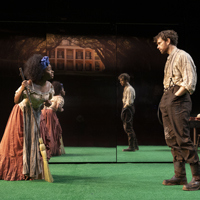 |
|
 |
CurtainUp The Internet Theater Magazine of Reviews, Features,
Annotated Listings |
|
A CurtainUp Review
Slave Play
By Jacob Horn
The truth is, though, that Slave Play is already spoiling one of its own big surprises right in its name. The title is a double entendre, speaking both to the play as a theatrical work as well as to the sexual role play that is its central concern. The first of the three acts features vignettes of what appear to be antebellum sexual encounters. But right away, there are clues that something is off. Kaneisha (Teyonah Parris) arouses her overseer Jim (Paul Alexander Nolan) by twerking to Rihanna. The mistress Alana (Annie McNamara) produces a modern-looking dildo to use on Phillip (Sullivan Jones). As Gary (Ato Blankson-Wood) supervises the work of an indentured servant, Dustin (James Cusati-Moyer), the two strip off their period-appropriate clothing, revealing Calvin Klein underwear. These aren't historical liberties, or lapses by the design team (Dede Ayite for costumes, Lindsay Jones for sound, and Noah Mease for properties). In fact, they're the seams of a radical therapy program that uses plantation role play to help interracial couples work through troubles in the bedroom. It's here that the real point of Slave Play emerges. The first act comes across as a modern take of the troublesome sexual misadventures of plantation life. But the latter two acts turn the focus on its head, looking at the messy and disconcerting ways that power, abuse, taboo, and otherness interweave the legacy of slavery with sexual desire. An enlightening program essay by dramaturg Amauta Marston-Firmino casts this relationship in academic terms. But what is so striking about Harris's writing is its accessibility and biting humor in dealing with complex and serious subject matter. The material can be rigorously intellectual, but that doesn't stop him from satirizing academics in the form of the therapy facilitators Teá and Patricia (played with pitch-perfect absurdity by Chalia La Tour and Irene Sofia Lucio, respectively). Even as he deals with real psychological phenomena, his characters acknowledge their incomprehensibility. The play asks a great deal of its ensemble, and the excellently cast group—under the skillful direction of Robert O'Hara, in whom Harris has found an ideal and sympatico collaborator—proves worthy of the challenge. Parris demonstrates impressive range and ably carries the play's heaviest dramatic weight. Nolan, completing the pair, disarms with his smooth transition between overseer and loving husband. Harris gives each couple their own distinct personalities and stakes, offering plenty of fuel for the group therapy session that is the sole focus of the lengthy second act. While this section of Slave Play is lower on action, and perhaps leaves room for some judicious pruning, it remains highly watchable. The snappy conversation, both painfully uncomfortable and audaciously funny, recalls the memorable second act of Bruce Norris's Clybourne Park, especially in lampooning the common sins committed by well meaning white folks—here most clearly embodied by McNamara's Alana. But as a playwright of color, Harris is able to probe deeper and in less obvious ways. Through Jones's Phillip, for example, he tackles the complexities of grappling with race for a lighter-skinned Black person. A central issue for Gary and Dustin, meanwhile, is what it means for Dustin to claim a non-white identity even if he passes so easily that he is considered white by his own partner. And if this sounds like a question of semantics, Blankson-Wood and Cusati-Moyer make perfectly clear in their performances that such questions are hardly trivial. Harris's obvious intention to speak outward is made physically manifest in the set as well. Scenic designer Clint Ramos positions a wall of mirrors facing the audience, which New York theater demographics would suggest is likely to skew overwhelmingly caucasian. Mirrored set designs are starting to feel overused after appearing in several major productions this year (including The Boys in the Band and Three Tall Women), but Ramos is even more direct. A traditional-looking backdrop painting of the plantation hangs not at the back of the stage but above the audience, becoming a floating spectre in reflection. The mirrors are topped with a text that seems to speak directly to the viewer. Jiyoun Chang's lighting also pointedly makes the audience more visible at specific junctures. All this serves as a not-so-subtle reminder of the need for self-reflection, even as we watch others doing the "processing" (a term that comes up repeatedly). There are many absurdly heightened moments in the play, like when Patricia talks over Teá to make a point about myopia causing someone to ignore their partner. It's so on-the-nose that, as an audience member, one can easily distance themselves from such behavior. But Harris doesn't want us to detach from or disclaim responsibility in what we're seeing. Without being heavy-handed or proscriptive, he makes clear that there is work required of all of us to reckon with the legacy of slavery in our modern understanding of race, sexuality, and identity. Quite often, a play with a more explicit agenda such as this one will be forced to sacrifice entertainment value, wit, relationships, or character development in order to make its point. Slave Play stands out for its refusal to compromise. In this laudable debut, Harris has his cake and eats it too, offering us a story that is both transporting and inescapably pertinent—a fantasy that is uncomfortably real. |
Search CurtainUp in the box below PRODUCTION NOTES Slave Play by Jeremy O. Harris Directed by Robert O'Hara with Ato Blankson-Wood (Gary), James Cusati-Moyer (Dustin), Sullivan Jones (Phillip), Chalia La Tour (Teá), Irene Sofia Lucio (Patricia), Annie McNamara (Alana), Paul Alexander Nolan (Jim), and Teyonah Parris (Kaneisha) Scenic Design: Clint Ramos Costume Design: Dede Ayite Lighting Design: Jiyoun Chang Sound Design and Original Music: Lindsay Jones Properties: Noah Mease Movement Director: Byron Easley Intimacy and Fight Director: Claire Warden Dramaturg: Amauta Marston-Firmino Dialect Coach: Dawn-Elin Fraser Stage Manager: Jhanaë K-C Bonnick Running Time: 2 hours with no intermission New York Theatre Workshop, 79 East 4th Street (between the Bowery and Second Avenue) Tickets: $99; (212) 460-5475, www.nytw.org, or in person at the theater From 11/19/2018; opened 12/9/2018; closing 1/13/2019 Performance times: Tuesdays–Thursdays at 7 pm, Fridays at 8 pm, Saturdays at 2 and 8 pm, and Sundays at 2 and 7 pm. No evening performance on Sunday, December 23, and no performance on Tuesday, December 25. Reviewed by Jacob Horn based on 12/14/2018 performance REVIEW FEEDBACK Highlight one of the responses below and click "copy" or"CTRL+C"
Paste the highlighted text into the subject line (CTRL+ V): Feel free to add detailed comments in the body of the email. . .also the names and emails of any friends to whom you'd like us to forward a copy of this review. For a feed to reviews and features as they are posted at http://curtainupnewlinks.blogspot.com to your reader Curtainup at Facebook . . . Curtainup at Twitter |